*Written for Kybernetes by Hugh Dubberly and Paul Pangaro*
*Abstract*
Argues design practice has moved from hand-craft to service-craft and that service-craft exemplifies a growing focus on systems within design practice. Proposes cybernetics as a source for practical frameworks that enable understanding of dynamic systems, including specific interactions, larger systems of service, and the activity of design itself. Shows development of first- and second-generation design methods parallels development of first- and second-generation cybernetics, particularly in placing design within the political realm and viewing definition of systems as constructed. Proposes cybernetics as a component of a broad design education.
*Key Words*
Cybernetics, design, design methods, hand-craft, interaction design, politics, rhetoric, service, service-craft, service design, system.
**A History of Connections Between Cybernetics and Design**
The influence of cybernetics on design thinking goes back 50 years.[1] Yet today, cybernetics remains almost unknown among practicing designers and unmentioned in design education or discussions of design theory.
Designers’ early interest in cybernetics accompanied cybernetics’ brief time in the spotlight of popular culture. First-generation thinking on cybernetics influenced first-generation thinking on design methods.[2] And second-generation design methods[3] has many parallels in second-order cybernetics.[4]
Both cybernetics and the design-methods movement failed to sustain wide interest. One reason is that initially both had limited practical application; in some sense, they were ahead of their times and the prevailing technologies. That may be changing. Particularly in the world of design, cybernetics is newly relevant.
Ross Ashby lists as the “peculiar virtues of cybernetics” its treatment of behavior and complexity.[5] Both topics increasingly concern designers, especially those designing “soft” products, those engaged in interface design, interaction design, experience design, or service design. In these areas, where designers are concerned with “ways of behaving”—with what a thing does as much as what it is or how it looks—here, cybernetics can help designers.
Designs Shift to Service-Craft
——
Over the last century, the arc of development of design practice[6] has been from objects, to systems, to communities of systems. Design practice has moved from a focus on hand-craft and form, through an increased focus on meaning and structure, to an increasing focus on interaction and services—what we call “service-craft.”
Service-craft includes the design, management, and ongoing development of service systems, the connected touch-points of service delivery. Touch-points are where participants interact with service providers or machines, either in person or through communications networks. For an airline, its website, check-in kiosk, flight attendants, and seats are some of many touch-points. Shelly Evenson describes service as “the experience participants have as they move through a series of touch-points.”[7]
For some people, service still connotes menial tasks, e.g., washing dishes. Yet service systems are at the cutting edge of consumer electronics, e.g., Apple’s iPod-iTunes-Store system or Nintendo’s Wii-online service. Service systems are also the very definition of e-business, e.g., Amazon, eBay, or Google.
Kevin Kelly, former editor of Wired magazine put it very well, “. . . commercial products are best treated as though they were services. It’s not what you sell a customer, it’s what you do for them. It’s not what something is, it’s what it is connected to, what it does. Flows become more important than resources. Behavior counts.”[8]
Today, the leading edge of design practice increasingly involves teams of people (often including many specialties of design) collaborating on the development of connected systems, teams of people collaborating in service-craft.
The difference between traditional and emerging design practice may be characterized as:
| | Hand-Craft | Service-Craft |
|—————-|—————|———————-|
| **Subject** | Things | Behaviors |
| **Participant(s)** | Individual | Team |
| **Thinking** | Intuitive | Reasoned |
| **Language** | Idiosyncratic | Shared |
| **Process** | Implicit | Explicit |
| **Work** | Concrete | Abstracted |
| **Construction** | Direct | Mediated |
Of course, hand-craft has not gone away, nor is service-craft divorced from hand-craft. Hand-craft plays a role in service-craft (just as in developing software applications, coding remains a form of handcraft). While service-craft focuses on behavior, it supports behavior with artifacts. While service- craft requires teams, teams rely on individuals. Service-craft does not replace hand-craft; rather service-craft extends or builds another layer upon hand-craft.
The Need for New Language in Design
——
Service-craft is emerging within the context of larger changes. The shift to a knowledge-service economy and the rise of information-communication technology are changing the way we live. The interplay of the two fuels the growth of both, which continues to accelerate. Another revolution is in the making, as sensors proliferate, e.g., Apple’s iPhone will include at least 5 sensors: camera, microphone, proximity sensor, motion sensor, and touch sensor (and maybe GPS, too). And more things have internet addresses, e.g., soon, you may be able to find your car keys by using Google.
These changes create opportunity for new products, new businesses, and new types of human activity. They create opportunity for new areas of design practice, but the approach to design that is efficient for a craftsman making individual objects does not scale for teams developing service systems. To take advantage of the opportunities now opening up, designers must develop new tools, new methods, and new language.
Service-craft requires new language—language that is not a part of hand-craft. The need for new language in service-craft stems from at least three sources.
First, service-craft takes place in teams. Each team member wants to know what to expect and what others expect in return. Communication is key. Process, goals, and measures must be made explicit to everyone on the team. Designers need new language to talk to each other about complex projects. Hand-craft has no such language.
Second, services are largely immaterial. Birgit Mager notes that services are manufactured at point of delivery.[9] Their essence is more about relationships than entities. In a sense, services are alive. Feedback and dialog (conversation) take on special importance. Designers need new language to help them discuss behavior. Hand-craft has no such language.
Third, systems often reveal only a few facets at one time. Understanding a whole system can be difficult. In service-craft, the final object of design cannot be viewed directly or in total. It must always be viewed in part, often only by proxy or through mediation. Trying to understand the community of systems that make up an online service such as Amazon is difficult, because we have nowhere to stand, which affords a complete view. Looking at Amazon through a web-browser is like looking at Versailles through a keyhole in a gate in the wall around the garden; you have a sense of a few parts but cannot easily grasp the complete structure. And for most visitors at least, the complex plumbing that powers the fountains remains almost invisible. Making matters more difficult, electronic systems change frequently. Designers need new language to represent dynamic systems. Hand-craft has no such language.
A language for thinking about living systems is becoming essential for the practice of design, at least in the world of service-craft.
Learning a new language increases our repertoire. New words may enable us to think about new ideas. More words may enable us to make finer distinctions. Our thinking and communicating become more precise—we become more efficient. We can work at deeper levels and take on more complex tasks—we become more effective. Our view of our work and ourselves takes on greater coherence—we become more integrated.
**Cybernetics as a Source for New Language in Design**
Forty years ago, in Notes on the Synthesis of Form, Christopher Alexander described the growing role of modeling in design practice.[10] In the last 10 years, much of design practice has come to rely on modeling. Designers have begun to develop language for discussing behavior—ways of understanding dynamic systems and visualizing patterns of information flows through systems.
Today, most models found in design practice are highly specific to the situation at hand. Designers rarely view the situation they are modeling as an example of a larger class and thus rarely draw on broader frameworks as a basis for their modeling. To be sure, designers have developed some conventions for modeling, e.g., site maps, application flow diagrams, and service blueprints. But for the most part, conventions for modeling are still not widely shared or well-defined within design practice.
In design discourse, most frameworks have been “cherry-picked” from the social sciences and semiotics. For the most part, designers have not established a firm foundation or organized systems for their modeling. Richard Buchanan’s formulation of design within frameworks of rhetoric—“design as rhetoric”—is a notable exception.[11]
The authors propose cybernetics as another rich source of frameworks for design practice, similar to the social sciences, semiotics, and rhetoric. We also propose cybernetics as a language—a self-reinforcing system, a system of systems or framework of frameworks for enriching design thinking.
Cybernetic Frameworks for Modeling What We Design
——
Much of design practice comes down to two models: a model of the current situation and a model of the preferred situation. Alexander points out the need to abstract the essence of the existing situation from the complexity of its concrete manifestation. Abstracting the situation makes it easier for us to consider meaningful changes, to find alternatives we might prefer. Alexander also underscores the need to make models visible, to provide representations for ourselves and others to analyze and discuss.[12]
Cybernetics offers conceptual frameworks for understanding and improving the things we design.
At the heart of cybernetics is a series of frameworks for describing dynamic systems. Individually these frameworks provide useful models for anyone seeking to understand, manage, or build dynamic systems. Together, these frameworks offer much of the new language design needs as it moves from hand-craft to service-craft.
In our teaching and in our practice, we have found seven cybernetic frameworks to be especially useful.
**1. First-Order Cybernetic System**
A first-order cybernetic system detects and corrects error; it compares a current state to a desired state, acts to achieve the desired state, and measures progress toward the goal. A thermostat-heater system serves as a canonical example of a first-order cybernetic system, maintaining temperature at a set-point.
A first-order cybernetic system provides a framework for describing simple interaction. It introduces and defines feedback. It frames interaction as information flowing in a continuous loop through a system and its environment. It frames control in terms of a system maintaining a relationship with its environment. It forms a coherence in which goal, activity, measure, and disturbance each implies the others.
This framework is useful for designers thinking about interfaces. It provides a template for modeling basic human interaction with tools, machines, and computers. It also provides a template for modeling machine-to-machine interaction or the interaction of processes running on computer networks.
**2. Requisite Variety**
Ross Ashby’s definition of requisite variety provides a framework for describing the limits of a system—the conditions under which it survives and those under which it fails. For example, humans have variety sufficient to regulate their body temperature within a fairly narrow range; if we get too cold or too hot, we will die quickly.
This framework is useful because it forces designers to be specific when describing systems. It suggests crisp definition of range, resolution, and frequency for measures related to goals, actuators, and sensors. The framework also enables discussion of the validity of goals. What is the range of disturbances we should design the system to withstand? Is the cost of additional variety in the system warranted by the probability of additional variety in disturbances?
**3. Second-Order Cybernetic System**
A second-order cybernetic system nests one first-order cybernetic system within another. The outer or higher-level system controls the inner or lower-level system. The action of the controlling system sets the goal of the controlled system. Addition of more levels (or “orders”) repeats the nesting process.
A second-order cybernetic system provides a framework for describing the more complex interactions of nested systems. This framework provides a more sophisticated model of human-device interactions. A person with a goal acts to set that goal for a self-regulating device such as a cruise-control system or a thermostat.
This framework is also useful for modeling complex control systems such as a GPS-guided automatic steering system. It is also useful for modeling ecologies or organizational or social control systems such as the relationship between insurer, disease management organization, and patient. This framework also provides a way of modeling the hierarchy of goals often at play in discussions of “user motivation,” which take place during design of software and service systems.
**4. Conversation, Collaboration, and Learning (Participatory System)**
Gordon Pask defined a conversation as interaction between two second-order systems.[13] This framework distinguishes between discussions about goals and discussions about methods, and it provides a basis for modeling their mutual coordination—or what Humberto Maturana called “the consensual coordination of consensual coordination of action.” It also distinguishes between it-directed (control) and other-directed (communication). Pask also used the framework in discussions of collaboration and learning. Michael Geoghegan wryly observed, “The mouse teaches the cat. . . Of course, . . . the cat also teaches the mouse.”[14]
This framework is useful for modeling the larger service systems in which many of the products of interaction design are situated. It provides a basis for beginning to model communities, exchanges, and markets, and interactions such as negotiation, cooperation, and collaboration.
The conversation framework suggests a sort of ideal: two second-order systems collaborating. Comparing this model of human-human interaction with typical human-computer interaction suggests many opportunities for improvement. Today, the typical framework for human-computer interaction might best be described as a second-order system (a person) interacting with a first-order system (a device). Designing second-order software systems to understand user goals and aid goal formation suggests a new way for people to work with computers.[15]
**5. Bio-cost**
The notion of bio-cost grows out of conversations between the authors and Michael Geoghegan. We define bio-cost as the effort a system expends to achieve a goal.[16]
This framework is useful for evaluating and comparing existing and proposed interaction methods. It may be possible to measure bio-cost and thus make notions of “ease-of-use” more concrete. We speculate that the bio-cost framework may be useful in developing key-performance indicator (KPI) systems for evaluating software usability and service quality.
**6. Autopoiesis**
Francisco Varela, Humberto Maturana, and Ricardo Uribe introduced the idea of autopoiesis or “self-making” to describe processes by which a system maintains itself and achieves autonomy.[17]
This framework is useful for discussing organizations and communities—how they form and how they maintain themselves. It holds promise for organizational designers. [The authors are aware of the disagreement as to whether the original, rigorous biological meaning holds for social organizations; we find the concept a unique and powerful metaphor for application to design in any case.]
**7. Evolution**
Geoghegan points out that “all evolution is co-evolution.”[18] A population changes in response to changes (disturbances) in its environment. In turn, the new population, behaving in new ways, may provoke changes in its environment. Of course, the idea of evolution by natural selection (or natural destruction) precedes the origin of cybernetics as a science, but framing evolution in cybernetic terms expands the scope and value of the earlier frameworks; for example, requisite variety can be seen as a mechanism of evolution and mutations as changes in variety. In addition, framing evolution in cybernetic terms strengthens the set of cybernetic frameworks, giving the whole a sort of completeness.
This framework is useful for discussing the evolution of services and businesses—and the process of innovation. Already, a few leading design thinkers such as John Rheinfrank and Austin Henderson [19] have begun to discuss designing for emergent behavior and designing for evolution. Still new is the idea that the product of design practice is not fixed, but rather something that will evolve as others use it and themselves design with it. We believe this idea will grow in importance and become a major trend in design. If that happens, frameworks for modeling evolution will be useful.
These seven frameworks are useful in a variety of ways, for example: analyzing existing systems; comparing systems which may at first appear very different; discerning and organizing patterns of interaction; and evaluating the way a proposed design fits its context. These frameworks apply at several scales: simple interaction between human and device; interaction among component sub-systems; interactions among people through devices or services; interactions between people and businesses (C2B) and between businesses (B2B); and interactions within markets.
These frameworks also provide a way to look forward in design and suggest the kinds of research from which design practice—and development of software applications and services—may benefit. Of particular interest for design research are systems that model user’s goals, systems that help users model and clarify their own goals, systems that facilitate participation, self-organizing systems, and systems that evolve.
Cybernetic Frameworks for Modeling How We Design
——
The previous section described the application of cybernetic frameworks to design practice. It emphasized using the frameworks to model existing situations and imagine preferred situations. It focused on using cybernetic frameworks to model what we design. This section focuses on using cybernetic frameworks to model how we design—to model the design process itself. Another way to approach this subject is to think of designing the design process; that is, adapting the design process to its context. Here again, cybernetic frameworks may be useful.
Cybernetics offers conceptual frameworks for understanding and improving design processes and thus their outcomes.
The seven frameworks we described in the previous section can also model the design process:
**1. First-Order Cybernetic System**
Design is a cybernetic process. It relies on a simple feedback loop: think, make, test (in Walter Shewhart’s words, “plan, do, check.”)[20] It requires iteration through the loop. It seeks to improve things, to converge on a goal, by creating prototypes of increasing fidelity.
In Herbert Simon’s words, “Design is devising courses of action aimed at turning existing situations into preferred ones.”[21] Alan Cooper has called this process “goal directed.”[22] When we design, we try to achieve goals, often by imaging the goals of people we hope will use our products.
A model of design as a feedback process applies equally well to design in the traditional hand-craft mode or in the new service-craft mode. In both cases, the designer relies on feedback. What differs is the nature of their prototypes and the degree to which they articulate their goals separately from their product.
**2. Requisite Variety**
Design teams, product development teams, or whole companies (as well as individual designers) have variety; that is, they have a set of skills and experience which they may bring to a project. We can evaluate the fitness of a team or even individuals for a task in terms of the variety they bring. Does the team have the variety required to be successful in this task? Of course, to answer the question, we must understand the goals of the task and possible disturbances.
**3. Second-Order Cybernetic System**
Douglas Engelbart has described a process he calls “bootstrapping”, which involves three nested cybernetic systems. Level 1 is “a basic process.” Level 2 is ‘a process for improving “basic processes.”’ And level 3 is a process for improving ‘the process of improving “basic processes.”’
Here’s an example. John’s team is responsible for producing a new widget—a level 1 process. John begins holding weekly meetings (Friday afternoon beer busts) at which his team discusses problems—a level 2 process. Implementing ideas from their meetings lowers the widget defect rate. Management asks John to share his improvement and decides to mandate Friday afternoon beer busts for the entire company—a level 3 process.
John Rheinfrank pointed out the need for three-level systems in creating sustained quality management and building true learning organizations.[23]
**4. Conversation**
Design is conversation, between designer and client, between designer and user, between the designer and himself or herself. Design involves the consensual coordination of goals and methods.
Framing design in terms of conversation has broad implications, challenging the designer’s role as expert and casting him instead as facilitator. [More about this idea later.]
**5. Bio-cost**
Robert Pirsig has written eloquently about “gumption traps,” ways in which people loose the energy necessary to sustain quality work.[24] A gumption trap is a source of bio-cost in the design process.
**6. Autopoiesis**
One of the great challenges facing the design profession is how it can create sustained learning about design practice. In recent years, several universities have begun to grant Ph.D.s in design, but design research is still young and relatively unformed. The feedback systems necessary to sustain it are not yet in place. Designers need a self-sustaining, learning system whose components make and re-make itself: the curricula must contain ‘the practice’ while also capturing processes that learn while also sustaining those that already exist. Inherent in the seven cybernetic frameworks are mechanisms to make such activities explicit for the design community and for the institutions (schools, consulting studios, and corporate design offices) that support it.
**7. Evolution**
Designers also lack tools for evolving their tools and processes. Progress is slow; innovation is infrequent. Globalization may put pressure on the current environment and force more rapid change.
A Constructivist View—Design as Politics
——
The design process is more than a feedback loop, more than a bootstrapping process, more even than a “simple” conversation. An approach to design that considers second-order cybernetics must root design firmly in politics. It views design as co-construction, as agreeing not just on solutions but also on problems. It recognizes what Horst Rittel called “the symmetry of ignorance” between designer and client.[25] It views design as facilitation—as managing a conversations about issues.
For Rittel the main thing in design was managing the myriad issues involved in defining what a team is designing. His view led to early work in creating issues-based information systems (IBIS), which provided a foundation for more recent research in design rationale, which is still an on-going area of inquiry.[26]
Heinz von Foerster pointed out the limitations of defining systems in objective terms. Von Foerster asked, “What is the role of the observer?”[27]
Horst Rittel pointed out the limitations of defining design in objective terms. Designers often describe their work as problem solving, but Rittel asked, “Whose problem is it?” He showed that the framing of the problem is a key part of the process. He posited agreement on definition of the problem as a political question. And he noted that some (“wicked-hard”) problems defy agreement, for example, in modern times, bringing peace to Palestine or creating universal health care.[28]
Rittel also noted that if design is political, then argumentation is a key design skill. Here is a design theorist with a background in physics and operations research, influenced by cybernetics, concluding design is not objective but instead political and thus rooted in rhetoric. He comes to the same conclusion as Richard Buchanan, who has a background in the humanities. This link is extraordinary.
A Call for Curriculum Change
——
Our culture is undergoing a change as profound as the industrial revolution, which gave birth to the design profession. The ongoing shift to a knowledge-service economy and the continuing growth of information-communication technology will profoundly change the practice of design.
Design educators need to respond to these changes.
Cybernetics can help designers make sense of the complex new world they face. Cybernetics can inform design on at least three levels: 1) modeling interaction—human-human, human-machine, or machine-machine, 2) modeling the larger service systems in which much interaction takes place, and 3) modeling the design process itself.
As the founders of cybernetics and the design methods movement pass away,[29] the risk increases that much of what they learned could be lost to future generations. That would be a tragedy.
We urge design educators to radically alter the current approach to design education and to adopt a systems view incorporating in their teaching the language of cybernetics—and rhetoric.
**1. First-Order Cybernetic System**
**2. Requisite Variety**
A regulator achieves a goal (preserves an essential
variable) against a set of disturbances. To succeed,
variety in the regulator must be equal to or greater
than the variety of disturbances threatening the
system. If this is so, we say the system has requisite
variety.
**3. Second-Order Cybernetic System**
An automatic feedback system (first-order) is
controlled by another automatic feedback system
(second-order). The first system is ‘nested’ inside
the second.
**4. Collaboration and Learning (Participatory System)**
**5. Bio-cost**
Bio-cost describes the effort
(in energy, attention, time, stress)
expended by an organism to reach a goal.
Value = Bio-gain – Bio-cost
**6. Autopoiesis**
Maturana writes,
“ . . . living beings are characterized in that, literally,
they are continually self-producing.”
They contain a set of dynamic transformations
that maintain themselves and their boundary.
The two arise together, not in sequence.
**7. Evolution (in Terms of Requisite Variety)**
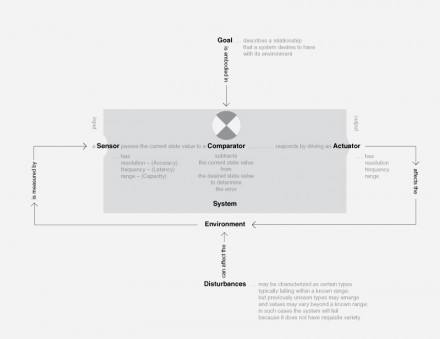
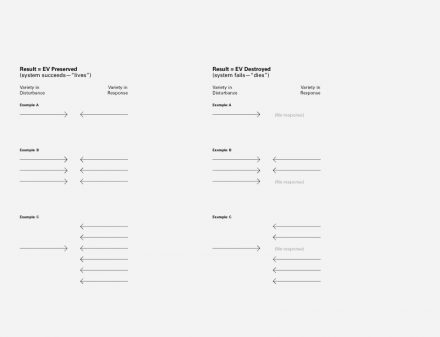
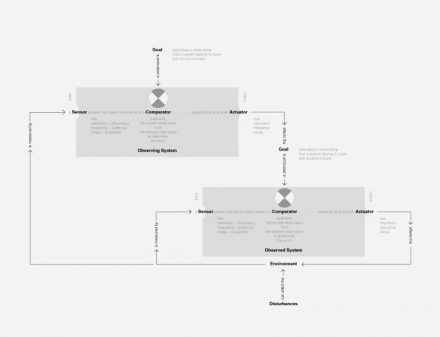
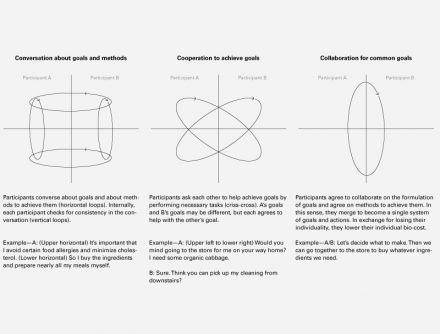
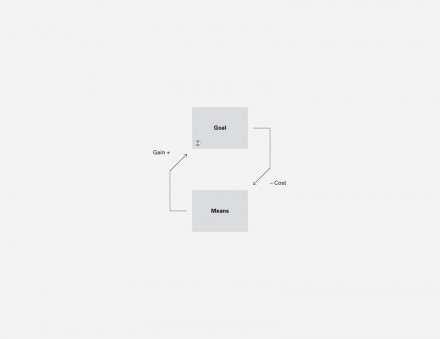
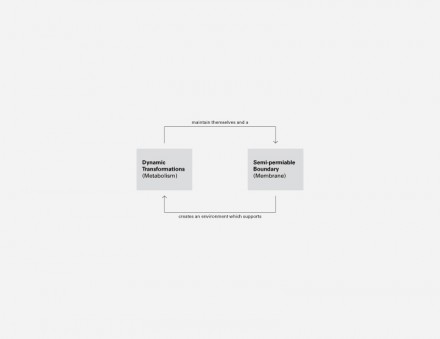
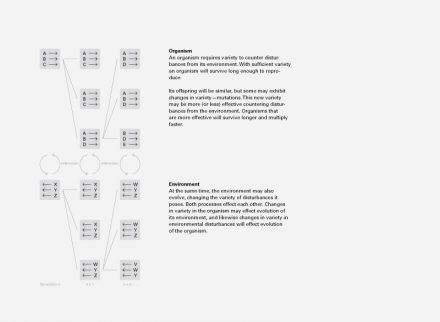
13 Comments
Putting People First in italiano » Articoli di Dubberly Design
Mar 12, 2009
9:27 am
[…] Cybernetics and service-craft: language for behavior-focused design Scritto per Kybernetes da Hugh Dubberly e Paul Pangaro – 19 Gennaio 2007 Scrivi un commento […]
Cybernetics and Service-Craft: Language for Behavior-Focused Design « IA // COLLAB
Sep 5, 2009
6:14 am
[…] http://www.dubberly.com/articles/cybernetics-and-service-craft.html […]
Cybernetics and Service-Craft: Language for Behavior-Focused Design « IA // COLLAB
Sep 5, 2009
6:14 am
[…] http://www.dubberly.com/articles/cybernetics-and-service-craft.html […]
Euge Ortiz
Dec 6, 2010
8:51 pm
Great article, thank you so much for explaining the relationship between cybernetics and design!
intihh
Sep 5, 2011
9:42 pm
there are many ideas a man can think but if he thinks it twice he thought about another idea which makes his idea nonsense…
RICHMAN MAZO
Sep 24, 2012
3:14 am
great article
Paul Ransfield
Nov 12, 2012
12:44 am
Thank you both.
Big ideas made useable, digestible, and as a PDF, shareable.
links for 2009-02-13 | zota
Dec 17, 2012
12:16 pm
[…] Cybernetics and Service-Craft: Language for Behavior-Focused Design Cybernetics as a Source for New Language in Design (tags: design cybernetics) […]
A case study on inclusive design: ethnography and energy use | Ethnography Matters
Feb 13, 2014
2:01 am
[…] by qualitative insights from ethnography, it misses so many of the details of real life. To draw on cybernetics terminology, if simplifying the complex world of behaviour means ignoring the variety of everyday experience, […]
Outside the Matrix: Dan Lockton | :InDecision:
Apr 22, 2014
2:02 am
[…] consider cybernetics. Read Hugh Dubberly and Paul Pangaro’s work and think about systems more broadly than the disciplinary boundaries within which you may have […]
As we may understand: A constructionist approach to ‘behaviour change’ and the Internet of Things | Architectures | Dan Lockton
Nov 2, 2014
7:28 am
[…] design is about modelling situations, as Hugh Dubberly and Paul Pangaro and before them, Christopher Alexander remind us. Even design which does not explicitly consider a […]
系统性思维之信息结构 – liangyingstudio
Jul 10, 2018
1:46 am
[…] [4]Hugh Dubberly. Cybernetics and Service-Craft: Language for Behavior-Focused Design[J/OL]. Dubberly Design Office, 2007: http://www.dubberly.com/articles/cybernetics-and-service-craft.html […]
As we may understand: A constructionist approach to ‘behaviour change’ and the Internet of Things | Imaginaries Lab | Dr Dan Lockton
Dec 5, 2022
1:34 pm
[…] encodes a hypothesis about human behaviour”. All design is about modelling situations, as Hugh Dubberly and Paul Pangaro and before them, Christopher Alexander remind us. Even design which does not explicitly consider a […]